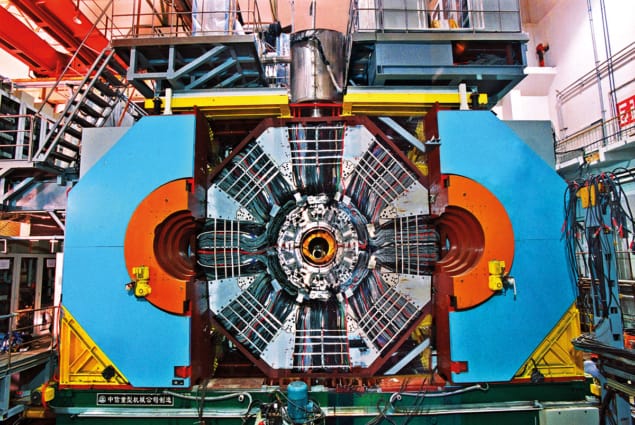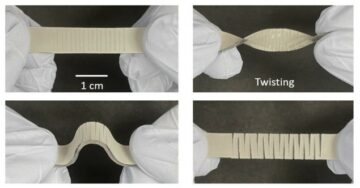Researchers in China want to build a $640m Super Tau-Charm Factory to test the Standard Model of particle physics and put the country at the forefront of precision studies. Ling Xin reports

Scientists in China want to build a new electron–positron collider to test the Standard Model of particle physics in unprecedented detail and keep the country at the forefront of precision studies on charm quarks and tau leptons. If approved, construction of the 4.5-billion-yuan ($640m) Super Tau-Charm Factory (STCF) in Hefei could begin in 2026. Operations would then start about five years later.
The STCF is seen as a natural successor to the Beijing Electron Positron Collider (BEPC), which opened in 1990. It consists of some 240 m of underground tunnels in the west of the city, where electrons and positrons are first accelerated to near the speed of light before being smashed into each other to generate a variety of subatomic particles. The trajectories, energies and electric charges are then recorded by the Beijing Spectrometer (BES) to reconstruct the reaction processes.
Working in the 2–5 GeV energy range, the BEPC has made a series of important discoveries, especially in charm quark and tau lepton physics. In 1996, for example, researchers used the collider to carry out precision measurements on the mass of the tau particle. It has also been used to study “exotic” particles containing four or more quarks.
At the forefront
Both the accelerator and the spectrometer at the BEPC underwent major upgrades in the 2000s to become what is known today as BEPC-II/BESIII, with the revamped collider expected to operate well into the early 2030s. However, its location and relatively small storage ring mean it will be difficult to achieve further performance improvements, which is why particle physicists in China are now turning to a new machine.
First proposed in 2011 by Peking University particle physicist Zhao Guangda, the STCF will have a similar design to the BEPC but be more than twice the size. Its linear accelerator will be 400 m long, while the two rings for storing electrons and positrons will each be about 800 m in circumference. With new accelerator technologies and a state-of-the-art spectrometer, STCF will operate with a centre-of-mass energy range of 2–7 GeV and with a peak luminosity of more than 0.5 × 1035 cm−2/s, about 100 times better than BEPC-II.
“The BEPC is one of the most fruitful and successful research facilities China has built,” says STCF chief scientist Zhao Zhengguo from the University of Science and Technology of China (USTC). “Yet compared to [BEPC], STCF will increase the collision rates by up to 100 times and open up a brand new energy region that has never been directly studied before.” According to project deputy chief scientist Zheng Yangheng from the University of the Chinese Academy of Sciences, the STCF will collect the same amount of data in three days as BESIII requires a year to gather.
This will make it possible to confirm, for the first time, if a tetraquark really has four quarks. “I expect the STCF would be able to make definitive measurements to finally reveal the internal quark structure of several exotic hadrons,” says Ryan Mitchell from Indiana University Bloomington, who is a member of the BESIII collaboration and supports the STCF conceptual design. “More importantly, it would also help us better understand how the strong force works to bind quarks together.”
We just don’t know what to expect in that energy range
Ryan Mitchell, Indiana University Bloomington
As the 5–7 GeV energy range has never been explored on any particle collider before, the STCF will open the door to uncharted territories and possibly even new physics beyond the Standard Model. “We just don’t know what to expect in that energy range,” adds Mitchell.
To achieve well-controlled collisions inside the STCF, Zhao and his team have been developing key technologies such as high-power electron and positron sources, superconducting magnets, and those for measuring and manipulating the beams with high precision. “Each electron or positron is supposed to pass the potential collision point millions of times during its life span,” says USTC’s Shao Ming, a leading physicist on the project. “For our designed luminosity we need to make sure that it hits the point with no more than a few hundred nanometres’ error.”
For the STCF to be 100 times more luminous than the BEPC-II, its spectrometer will need to be better at handling electronic signals from the detector. To that end, partnerships have been fostered with domestic companies. These include chip, sensor and semiconductor manufacturers that can create components that China cannot buy from western nations due to export embargoes. “The synergy has worked out well for our project and for the industry,” adds STCF chief engineer Yin Lixin from the Shanghai Advanced Research Institute.
The next generation
While funding is less of an issue than it used to be because local governments are putting more money and giving a high priority towards hosting big-science facilities, the STCF does face competition. One is from a next-generation Higgs factory – the Circular Electron Positron Collider (CEPC) – a 100 km ring that will run at much higher energies but be much more costly too.

China’s premier particle collider set for major upgrade
The CEPC is also aiming to start construction by 2030 but it remains a possibility that both could get the go-ahead. “The STCF and the CEPC don’t need to be contradictory because they do very different science,” says Zhao. “Though the two projects are less likely to happen at the same time, a few years’ gap in implementation might increase the chance for both to be built eventually.”
Discussions about what projects to recommend for China’s upcoming 15th five-year plan, which runs from 2026 to 2030, have already begun within China’s high-energy physics community. While both the STCF and the CEPC will be led by China, the STCF already has about 500 scientists from 74 universities and research institutes in Asia, Europe and the US. Zhao admits it is a challenge to make the STCF a truly international effort due to geopolitical tensions and other factors, but is positive that they will have a minimal impact.
“Like all particle-physics experiments in the world, the STCF will serve the global particle physics community and we welcome colleagues with different expertise to join us in Hefei,” adds Zhao. “The STCF will allow China to continue to lead the world in tau-charm physics and related technologies for decades to come – China is finally standing at the forefront.”
- SEO Powered Content & PR Distribution. Get Amplified Today.
- PlatoData.Network Vertical Generative Ai. Empower Yourself. Access Here.
- PlatoAiStream. Web3 Intelligence. Knowledge Amplified. Access Here.
- PlatoESG. Automotive / EVs, Carbon, CleanTech, Energy, Environment, Solar, Waste Management. Access Here.
- BlockOffsets. Modernizing Environmental Offset Ownership. Access Here.
- Source: https://physicsworld.com/a/china-mulls-plan-to-build-a-640m-super-tau-charm-factory/
- :has
- :is
- :where
- $UP
- 100
- 1996
- 2011
- 2026
- 2030
- 500
- a
- Able
- About
- Academy
- accelerated
- accelerator
- According
- Achieve
- Adds
- advanced
- Aiming
- All
- allow
- already
- also
- amount
- an
- and
- any
- approved
- ARE
- AS
- asia
- At
- BE
- because
- become
- been
- before
- begin
- begun
- Beijing
- being
- Better
- Beyond
- bind
- both
- brand
- Brand New
- build
- built
- but
- buy
- by
- CAN
- cannot
- carry
- challenge
- Chance
- charges
- chief
- China
- Chinas
- chinese
- chip
- City
- collaboration
- colleagues
- collect
- come
- community
- Companies
- compared
- competition
- components
- conceptual
- Confirm
- consists
- construction
- continue
- costly
- could
- country
- create
- data
- Days
- decades
- definitive
- deputy
- Design
- designed
- detail
- developing
- different
- difficult
- directly
- do
- does
- Domestic
- Dont
- Door
- due
- during
- each
- Early
- effort
- Electric
- Electronic
- electrons
- end
- energy
- engineer
- error
- especially
- Europe
- Even
- eventually
- example
- Exotic
- expect
- expected
- experiments
- expertise
- Explored
- export
- Face
- facilities
- Facility
- factors
- factory
- few
- Finally
- First
- first time
- For
- Force
- forefront
- four
- from
- funding
- further
- gap
- gather
- generate
- geopolitical
- get
- Giving
- Global
- Governments
- Handling
- happen
- Have
- help
- High
- higher
- his
- Hits
- hosting
- How
- However
- HTML
- http
- HTTPS
- hundred
- if
- image
- Impact
- implementation
- important
- improvements
- in
- include
- Increase
- industry
- information
- inside
- Institute
- internal
- International
- into
- issue
- IT
- ITS
- join
- Join us
- jpg
- just
- Keep
- Key
- Know
- known
- later
- lead
- leading
- Led
- less
- Life
- light
- likely
- local
- location
- Long
- machine
- made
- Magnets
- major
- make
- manipulating
- Manufacturers
- Mass
- max-width
- mean
- measurements
- measuring
- member
- might
- millions
- minimal
- model
- money
- more
- most
- much
- Nations
- Natural
- Near
- Need
- never
- New
- next
- next-generation
- no
- now
- of
- on
- ONE
- open
- opened
- operate
- operation
- Operations
- or
- Other
- our
- out
- partnerships
- pass
- Peak
- Peking
- performance
- Physics
- Physics World
- plan
- plato
- Plato Data Intelligence
- PlatoData
- Point
- positive
- possibility
- possible
- possibly
- potential
- Precision
- premier
- priority
- processes
- project
- projects
- proposed
- put
- Putting
- Quarks
- range
- Rates
- reaction
- really
- recommend
- recorded
- region
- related
- relatively
- remains
- requires
- research
- researchers
- revamped
- reveal
- Ring
- Run
- runs
- same
- says
- Science
- Science and Technology
- SCIENCES
- Scientist
- scientists
- seen
- semiconductor
- Series
- serve
- set
- several
- shanghai
- signals
- similar
- since
- Size
- small
- some
- Sources
- span
- speed
- standard
- start
- state-of-the-art
- storage
- storing
- strong
- structure
- studied
- studies
- Study
- subatomic particles
- successful
- such
- Super
- superconducting
- Supports
- supposed
- sure
- synergy
- team
- Technologies
- Technology
- tensions
- territories
- test
- than
- that
- The
- The West
- the world
- then
- These
- they
- those
- three
- thumbnail
- time
- times
- to
- today
- together
- too
- towards
- true
- truly
- Turning
- Twice
- two
- understand
- Universities
- university
- University of Science and Technology of China
- unprecedented
- upcoming
- upgrades
- us
- used
- USTC
- variety
- very
- want
- we
- welcome
- WELL
- West
- Western
- What
- What is
- which
- while
- WHO
- why
- will
- with
- within
- worked
- works
- world
- would
- year
- years
- zephyrnet
- Zhao













